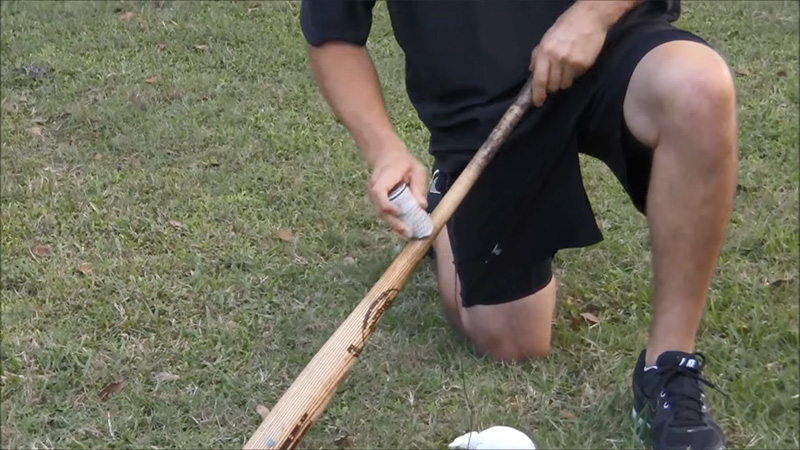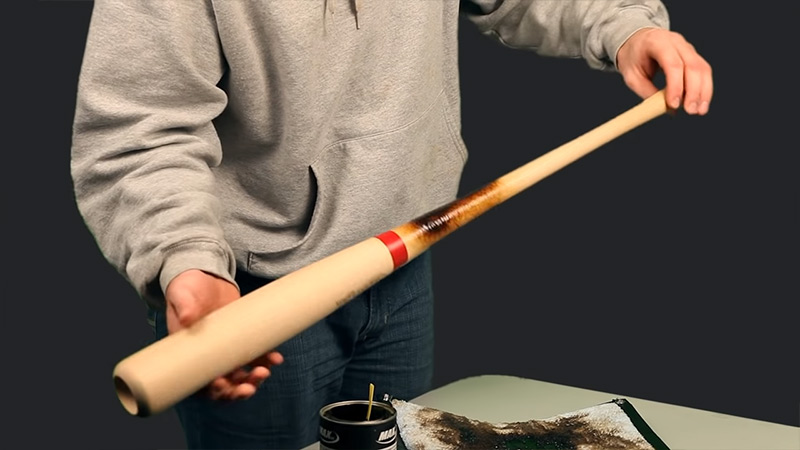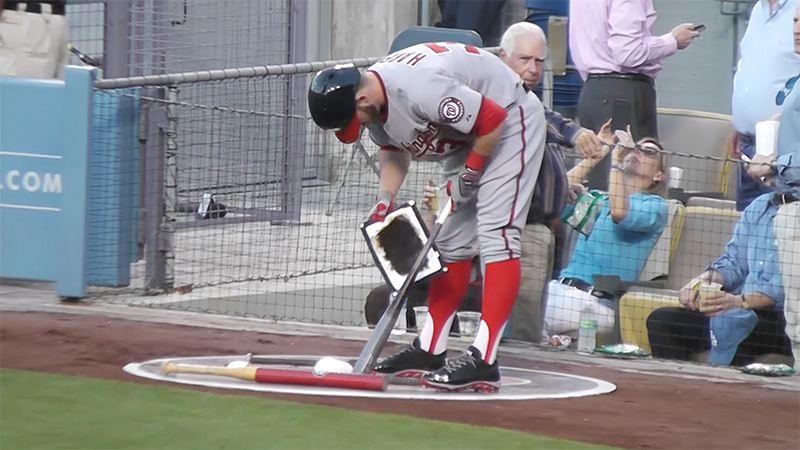The grip is an essential aspect of success in baseball, as it directly impacts a player’s ability to control the bat and make solid contact with the ball.
To enhance grip and prevent the bat from slipping out of their hands during the swing, players often turn to various grip-enhancing substances and technologies.
One such substance that has gained prominence is pine tar, known for its sticky and tacky feel. Pine tar provides an improved grip, giving players greater control over the bat throughout the mechanics of their swing.
This article will delve into the purpose, impact, alternatives, and rule enforcement related to grip-enhancing substances and technologies in baseball.
The Purpose of Pine Tar to a Baseball Bat
Some key purposes of pine tar on a baseball bat are mentioned in a comprehensive manner in the following part of this article.
Enhancement of Grip and Control
Pine tar serves as a remarkable aid in enhancing a batter’s grip and control over the baseball bat. When a batter steps up to the plate, they need to have a secure hold on the bat to execute a powerful and accurate swing.
The sticky nature of pine tar provides a tacky surface that effectively reduces the chances of the bat slipping from their hands during the swing.
With a firm grip facilitated by pine tar, batters gain better control over the bat’s movement. This improved control allows them to make precise adjustments in their swing and make solid contact with the ball.
By minimizing the risk of the bat slipping or twisting in their hands, pine tar helps batters maintain a consistent swing path and achieve greater accuracy in their hits.
Prevention of the Bat From Slipping Out of the Batter’s Hands
One of the key benefits of using pine tar on a baseball bat is its ability to prevent the bat from slipping out of the batter’s hands during a swing.
Baseball games are often played in varying weather conditions, which can include high humidity or rain. These conditions can make the handle of the bat slippery and increase the likelihood of losing grip.
Pine tar creates a tacky surface on the handle of the bat, enabling the batter to maintain a strong hold even in adverse conditions.
The stickiness of the pine tar significantly reduces the chances of the bat slipping out of their hands, allowing the batter to swing confidently without worrying about losing control mid-swing.
Impact on the Mechanics and Speed of the Swing
The mechanics and speed of a batter’s swing play a crucial role in their ability to generate power and hit the ball effectively.
Pine tar can have a positive impact on these aspects of the swing. By providing a tacky surface, pine tar enables batters to have a more secure grip on the bat throughout the swing.
With a firm grip facilitated by pine tar, batters can generate more bat speed. A faster swing allows the batter to make solid contact with the ball, resulting in greater power and potentially increased distance on the hit.
The added control and grip offered by pine tar contribute to smoother swing mechanics, allowing batters to optimize their swing and make the most of their physical abilities.
Increased Control and Accuracy of Baseball Bats
Pine tar’s sticky nature creates a tacky feel on the handle of the baseball bat, improving the batter’s grip. When batter holds a bat treated with pine tar, they experience a stronger connection between their hands and the bat.
The tackiness of the pine tar helps to create friction between the bat and the batter’s gloves or bare hands, ensuring a more secure grip.
With an improved grip facilitated by pine tar, batters gain better control over the bat. This control allows them to manipulate the bat’s position and make necessary adjustments during their swing.
The tacky feel provided by the pine tar contributes to a sense of stability and confidence, enabling batters to have a more controlled and accurate swing.
Pine tar’s tacky feel and improved grip enhance a batter’s control and accuracy. The increased control allows batters to make solid contact with the ball, leading to more consistent hits.
Additionally, it enables batters to place the ball in desired locations, contributing to strategic offensive play and maximizing their hitting potential at the plate.
Generating Power and Distance by Pine Tar
Bat speed plays a crucial role in generating power in a baseball swing. The faster the bat’s speed, the more force can be transferred to the ball upon contact.
This increased force leads to greater power in the hit, resulting in the potential for longer distances the ball can travel.
Pine tar can contribute to an increase in bat speed due to its impact on grip and control. When a batter has a firm grip facilitated by pine tar, it can swing the bat with more confidence and aggression.
The enhanced grip allows them to fully utilize their swing mechanics and generate more speed through the hitting zone.
With a secure hold on the bat, batters can unleash their swing with greater force and speed. The tacky feel provided by pine tar helps prevent the bat from slipping or rotating in their hands, allowing them to maintain control throughout the swing.
This enhanced control translates to increased bat speed, which in turn leads to a more powerful hit. The additional power generated through the use of pine tar can lead to increased distance on hits, potentially turning routine fly balls into home runs or deep line drives into extra-base hits.
Application of Pine Tar on a Baseball Bat

Here the application process of pine tar on a baseball bat is discussed in the following part. Check them out below.
Proper Application Techniques and Regulations
When applying pine tar to a baseball bat, it is essential to follow proper techniques and adhere to the regulations set forth by the league or organization.
Each league may have specific guidelines regarding the amount and placement of pine tar on the bat. It is crucial to familiarize oneself with these rules to ensure compliance.
To apply pine tar correctly, typically a small amount is spread evenly on the handle of the bat. Players often use a rag or cloth to rub the pine tar onto the handle, creating a thin layer.
It is important not to apply excessive pine tar, as it may lead to a violation of the rules or affect the bat’s performance.
Where on the Bat Should Pine Tar Be Applied?
Pine tar should be applied to the handle of the baseball bat. The general rule is that pine tar can be applied to the handle up to 18 inches from its end.
This range allows players to have a secure grip on the handle without extending the pine tar onto the barrel of the bat, which could impact the ball’s flight or potentially violate regulations.
By focusing on the handle, pine tar enhances the grip and control where the batter’s hands make contact with the bat during the swing. This targeted application ensures that the benefits of pine tar are utilized effectively without interfering with the performance of the barrel.
Things to Consider While Using Pine Tar During an At-bat
Using pine tar during an at-bat requires certain considerations to optimize its effectiveness. Firstly, it is important to ensure that the pine tar application remains within the approved limits as per league regulations.
If the pine tar extends beyond the permitted range, the bat may be removed from play.
During an at-bat, batters may choose to reapply pine tar if they feel the need for additional grip or tackiness. Some players prefer to have a fresh application of pine tar before each plate appearance to ensure a consistent feel.
However, it is crucial to be mindful of any excess pine tar that may transfer to the ball, as this can affect its flight or result in the ball being taken out of play.
Batters should also be aware of their personal preference regarding the amount of pine tar used. Some players may prefer a heavier application for a stronger grip, while others may opt for a lighter application.
Pine Tar and Rule Enforcement

Some of the rule enforcements of pine tar are discussed in the following section. Take a look at them with proper care.
Rules and Restrictions Regarding Pine Tar Usage
Pine tar usage in baseball is subject to rules and restrictions to maintain fair play and the integrity of the game. Leagues, such as Major League Baseball (MLB), have specific guidelines governing the application and extent of pine tar usage on bats.
One of the main rules is that pine tar should be applied to the handle of the bat and should not extend beyond 18 inches from its end. This limitation ensures that the pine tar does not come into contact with the ball, which could alter its flight characteristics or potentially give an unfair advantage to the batter.
It is crucial for players to familiarize themselves with the specific rules of their league or organization to avoid any violations.
Famous Incidents and Controversies Related to Pine Tar
Over the years, there have been notable incidents and controversies surrounding the use of pine tar in baseball. Perhaps the most famous incident occurred on July 24, 1983, when George Brett of the Kansas City Royals hit a home run against the New York Yankees.
The opposing team contested that Brett’s bat had excessive pine tar, and after a protest, the home run was nullified. However, the decision was later overturned, highlighting the importance of interpreting and enforcing the rules accurately.
Other incidents have involved pitchers inspecting opposing players’ bats for potential pine tar violations, leading to confrontations and disputes on the field.
These incidents serve as reminders of the scrutiny and attention given to pine tar usage and the potential impact it can have on the outcome of a game.
Consequences for Violating Pine Tar Regulations
Violating pine tar regulations can result in consequences for the player and potentially affect the outcome of a game. If a bat is found to have excessive pine tar or if the pine tar extends beyond the permitted 18-inch limit, the bat may be removed from play.
The player using the bat will not face any personal penalties, but they will be required to replace the bat with a properly treated one.
In cases where a violation occurs during an at-bat, such as when excessive pine tar is observed on the bat after a hit, the ball may be taken out of play.
The opposing team may request an inspection by the umpires, who have the authority to enforce the rules and make decisions regarding the use of pine tar.
It is crucial for players and teams to adhere to pine tar regulations to maintain fair competition and uphold the integrity of the game. Understanding and respecting the rules surrounding pine tar usage helps ensure a level playing field for all participants.
Alternatives to Pine Tar for Baseball Bats
Here, some of the alternatives to pine tar for baseball bats are mentioned in the following section. Check them out below.
Other Grip-enhancing Substances Used by Players
In addition to pine tar, baseball players have explored various other grip-enhancing substances to improve their hold on the bat. These substances include specialized grip tapes, batting gloves, and adhesive sprays.
Grip tapes provide a textured surface that enhances grip and can be customized to the player’s preference. Batting gloves offer a combination of grip and comfort, allowing players to maintain a secure hold on the bat.
Adhesive sprays create a tacky surface on the handle, providing additional grip support. Each of these alternatives offers unique advantages and may be preferred by different players based on their individual preferences and playing style.
Pros and Cons of Different Grip Aids
When considering grip aids, it is essential to evaluate their pros and cons. Pine tar, for instance, is known for its sticky feel and provides excellent grip in various weather conditions.
However, it can be messy and may require regular reapplication. Grip tapes offer customization options and can be easily replaced, but they may not provide the same level of tackiness as pine tar.
Batting gloves provide comfort and grip, but some players may find them restrictive or prefer the direct feel of the bat handle. Adhesive sprays offer convenience and consistent tackiness, but they may be subject to usage restrictions or limitations in certain leagues.
Assessing the advantages and drawbacks of each grip aid helps players make informed choices based on their specific needs.
Grip Enhancing Substances and Technologies
Grip Aid | Description | Pros | Cons |
Pine Tar | A sticky substance was applied to the bat handle | Excellent grip in various conditions | Messy application, regular reapplication |
Grip Tape | Textured surface applied to the handle | Customizable, easy to replace | May not provide the same level of tackiness |
Batting Gloves | Gloves are worn for improved grip and comfort | Comfortable, offer grip support | Some players find them restrictive |
Adhesive Sprays | The tacky spray was applied to the handle | Convenient, consistent tackiness | Usage restrictions, limitations in leagues |
Synthetic Grips | Specialized grips made from synthetic materials | Durable, moisture-resistant | Varies depending on grip design and quality |
Adhesive Grip Wraps | Adhesive wraps for customizable grip | Customizable, easy application | Grip durability may vary |
FAQs
Are there any rules or restrictions on using grip-enhancing substances or technologies in baseball?
While the use of grip-enhancing substances like pine tar is regulated, other grip aids such as grip tapes, batting gloves, and adhesive sprays are generally allowed within certain guidelines.
It is important to familiarize yourself with the specific rules of your league or organization to ensure compliance with any restrictions on grip aids.
Can grip-enhancing substances or technologies give a player an unfair advantage?
Grip-enhancing substances or technologies are primarily used to improve the grip and control of the bat. While they can enhance a player’s performance, their impact on the game is typically considered within the realm of fair play.
However, excessive or illegal use of certain substances may lead to penalties or consequences as per the regulations of the league or organization.
Are there any safety concerns associated with grip-enhancing substances or technologies?
In general, grip-enhancing substances and technologies do not pose significant safety concerns when used appropriately. However, it is important to follow proper application techniques and ensure that grip aids do not compromise the player’s ability to safely handle the bat or interfere with the natural mechanics of the swing.
It is advisable to choose grip aids that provide a secure grip without causing discomfort or hindering the player’s ability to react quickly.
Can grip-enhancing substances or technologies be used by pitchers?
Grip-enhancing substances like pine tar are prohibited for use by pitchers as they can provide an unfair advantage by altering the ball’s flight or movement.
Pitchers are subject to specific rules regarding the use of substances on their hands or the ball to maintain the integrity of the game. However, pitchers may utilize grip aids like grip tapes or specialized gloves to improve their grip on the baseball within the allowed guidelines.
Conclusion
Grip-enhancing substances and technologies play a significant role in baseball, providing players with improved grip, control, and comfort when handling the bat.
Pine tar, grip tapes, batting gloves, adhesive sprays, synthetic grips, and adhesive grip wraps are among the options available to players seeking to enhance their grip.
Each of these grip aids has its own advantages and considerations, such as tackiness, customization, durability, and compliance with league regulations.
Safety and comfort should always be prioritized when choosing and applying grip aids. Thank you for staying with us.







